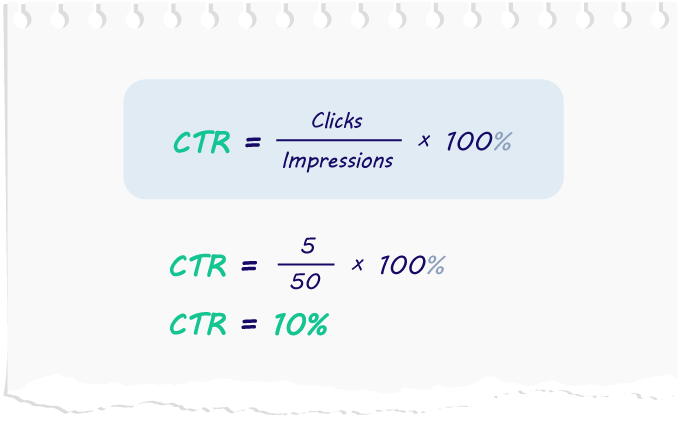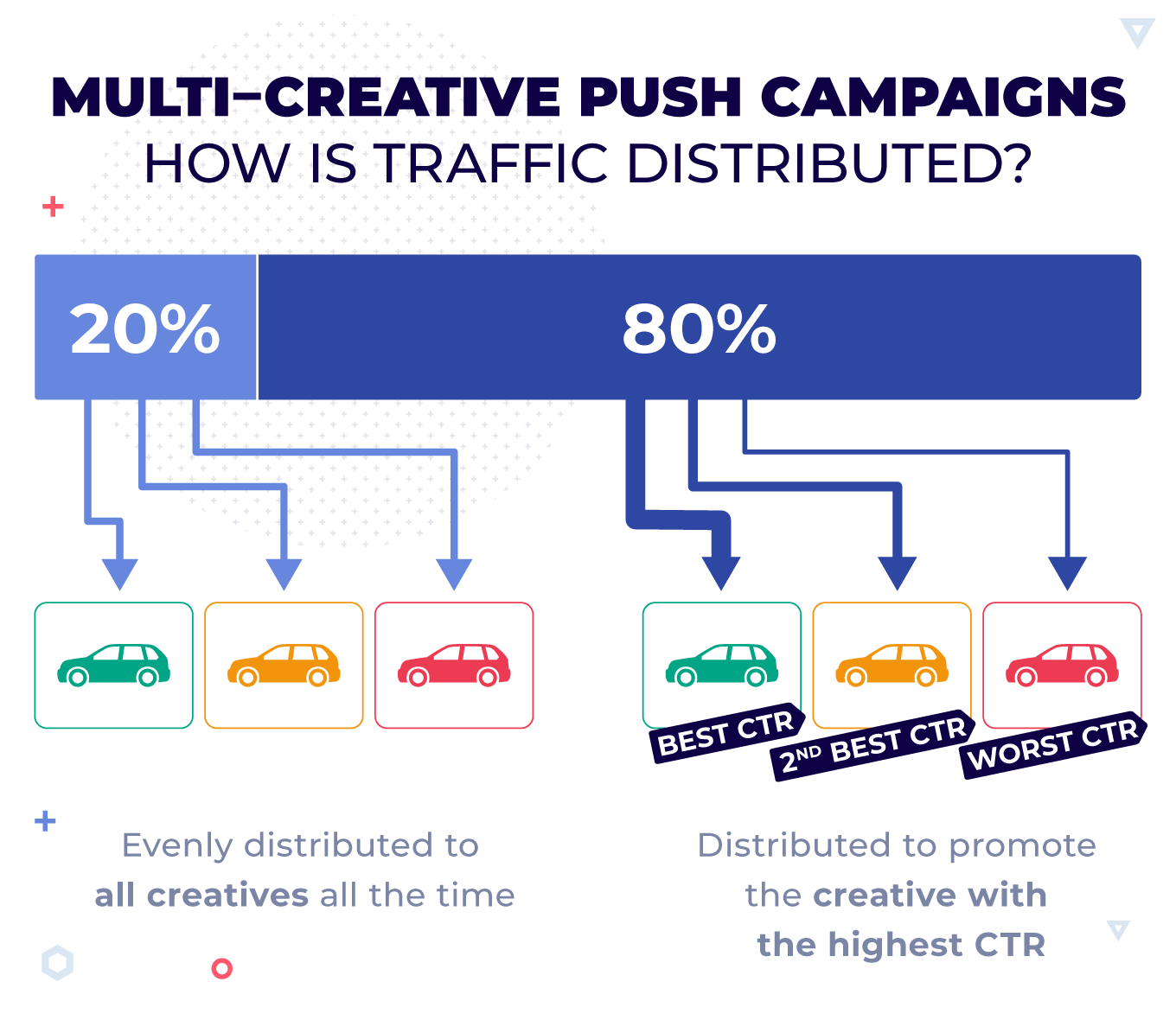Contents
Click-Through Rate in multi-creative push campaigns – Zeropark Case Study
•
There are many metrics in affiliate marketing. If you want your campaigns to perform well, you need to pay attention to data. ROI is important but it’s not everything. It’s easy to determine what ROI percentage is good (as long as the number is green, duh!) but other metrics might not be as clear.
If you look around the affiliate marketing communities, you’ll find that CTR is one of the most confusing and asked about metrics. How does it work? What percentage signals campaign potential? How is CTR affected by the number of creatives?
Zeropark’s business analytics team decided to take up the challenge and look into the behavior of multi-creative push campaigns. Read and find out all there is to know about push ads CTR and learn about Zeropark’s mechanisms of multivariate push ad testing.
How do you calculate click-through rate (CTR)?
Before we dive into the technicalities of our study, we’ll do a rundown of the basics for our readers who are only just starting their affiliate marketing journeys. A click-through rate (CTR) is the number of clicks (on your advert or landing page) divided by the number of impressions (how many times the ad was shown). That number is then turned into a percentage.
You can take a look at the formula and example below.

In push traffic, the click-through rate is calculated for the push notifications first. Then, if a landing page is used, it’s calculated once more. This time to measure the performance of landing pages.
Of course, this metric is not limited to push traffic and landing pages only. It’s equally important for banner ads, search ads and search results, links placed on websites and social media, or in an email marketing campaign. Whenever you have a clickable element on a website, lander, advert, or sponsored post, you can and should measure the click-through rates.
If you want to learn everything there is to know about push ads then click here to read the ultimate guide to push advertising.
What is a good click-through rate?
How many click-throughs your ad campaign gets can depend on many factors. Starting with the quality of the offer, targeted audience, ad position, the appeal of your creatives, and ending with the most important factor – the ad format.
Let’s go through the most important types of internet marketing to see what their average click-through rates are.
Email marketing – various sources such as MailChimp or Campaign Monitor state the average CTR to be about 2.5% for the links included in the promotional mailings. While click-through rate is an important factor, email marketers measure their success by monitoring the email open rate, and that averages 15-25%.
Search ads – a PPC Google search ad should receive an average of 2% click-through rate as reported by WordStream. This number, however, differs across the industry and provides different values depending on the niche (e.g. dating ads will see twice as many clicks as e-commerce ads).
Display ads – according to Forbes, joining a display network will produce an average CTR of 0.16% calculated based on worldwide stats. While the number of click-throughs might seem absurdly low, it is based on Google benchmarks and can be assumed to be a correct estimate, which considers subtracting both bot clicks and accidental clicks.
Social media ads – if we look at the data from Statista we’ll see that the average click-through rate for PPC ads featured on various social media platforms currently amounts to 1.3%. Although the number seems to fluctuate over the years it’s unclear whether it’s inclining or declining.
Native ads – a native advertisement is predicted to receive an average click-through rate of 0.2% as reported by Outbrain. It’s worth noting that the number is higher on mobile (0.38%) and lower on desktop (0.16%) and is a global statistic.
Pop, push, domain redirects – click-through rates for the popular PPC and PPV affiliate marketing campaigns are the hardest to determine. Within one affiliate marketer’s dashboard, you will most likely see a CTR of 2% right next to another creative with 15% and both will be equally profitable. Just take a look at the example of data:

The number here can typically vary between a fraction of a percent to around 30%. But it can just as easily be much higher. Here are the main factors affecting your CTR:
- GEO – usually, the more expensive the targeting, the lower the CTR.
- Vertical – broad topics such as dating or sweepstakes will receive higher CTR than, for example, auto insurance services.
- Device – the CTR is usually higher on mobile devices.
- Ad format – the cheaper the impressions the lower the CTR.
Is click-through rate a KPI?
Yes, click-through rate is a key performance indicator (KPI). Right next to the conversion rate (CR) it’s a crucial metric in measuring the performance of your campaign. In the case of any push ad campaign, CTR will measure the effectiveness of your ad copy/image/keywords used.
If the ratio of impressions to clicks is low and your ROI is well below zero, it means the content of your advertisement does not manage to attract any clicks. In that case, the CTR is a key performance indicator and a quality score of each ad separately.
If you’re using a search network, such as Google, you might be looking at the click-through rate as a KPI for a keyword or ad placement. Similarly, if you’re doing SEO affiliate marketing, your click-through rate will serve as a key performance metric for how well you’re positioning your website in the search engines’ results pages for a given keyword or keyword phrase.
If people are seeing your link/advertisement while searching for a specific keyword and yet you’re not receiving conversions it means you are most likely reaching the wrong target audience.
Remember that click-through rate is only significant together with ROI.
Although it is not confirmed whether Google takes CTR into consideration while deciding on your organic rankings, you might be better off treating CTR as a valid benchmark. If users click on your ads and links because they like their content and find it relevant, it does make perfect sense this information will be noted by Google and used while calculating your position on the search results page.
Additionally, Google uses CTR to calculate your quality scores and ad rank. So, even if you’re not using a search network you can see now that click-through rate is a very important benchmark that is widely adopted by the biggest companies in the advertising industry.
Need some tips on how to read data?
Learn about the top metrics in affiliate marketing!

Zeropark Case Study
Now that we’ve laid out the basics of click-through rate (CTR) as one of the most important benchmarks in affiliate marketing, it’s time for the Zeropark analytics part.
The Zeropark platform wants you to succeed just as much as you want to succeed. That’s why we have our own internal algorithms that help boost the creatives that get the most user attention. If you’re amongst the people wondering how it works (and does it actually work!?) then here are the results of one of the case studies conducted by our business analytics team.
How is traffic distributed in multi-creative push campaigns?
We all know cashing in on the creatives that perform best is equally important to driving enough traffic to other ads so that you don’t miss out on a gem simply because you didn’t manage to discover its potential.
Hence, traffic in Zeropark is split into two portions. The first part which constitutes 80% of traffic is distributed according to performance. So, the ad with the highest click-through rate will be the one that receives the most traffic, while the ad with the lowest CTR will receive the least traffic.
The other portion of traffic, being just 20%, is evenly distributed to all creatives regardless of their performances. That ensures that even the creatives that don’t perform right off the bat continue getting a supply of traffic throughout the run of the campaign.

But what happens when you add new creatives?
When you add more creatives, at first, they will only receive their share of the 20% of traffic. Once enough impressions are delivered to each advertisement, the click-through rate (CTR) will serve as a sort of quality score (or ad rank). As a result, creatives that received more clicks will now receive more impressions so they can compete with older creatives for the top creative spot.
If you want to increase the amount of traffic going to the new creatives, it’s recommended that you lower the total number of creatives in each campaign. That way, the 20% of evenly distributed impressions will be split into bigger fractions for each creative.
It’s worth noting that the algorithm’s response is immediate. As soon as the number of clicks starts rising, so will the number of impressions. And although older creatives will receive an overall higher number of impressions, new creatives that show potential can join your top assets in an instant.
How does the CTR change over time?
It’s not a secret that click-through rates change over time. After all, if you display one advert to the same audience over and over again, you’ll have a head-on collision with creative fatigue. But since you’re here for the numbers, let’s get to the findings of another case study conducted by Zeropark.
Over the period of 3 months, we’ve gathered data from thousands of both single and multi-creative campaigns. The creatives we looked at have been in the running for at least 30 days without breaks longer than 2 days. Our results can be split into two groups.
- Creatives that were receiving over 1 million impressions per month have seen a 25% decrease in CTR (after their impression count reached a total number of 50 times the first-day impression count);
- Creatives that were receiving below 1 million impressions per month have seen a 30% decrease in CTR (after their impression count reached a total number of 50 times the first-day impression count).
So, in short, the total number of impressions the creative receives does have an effect on how fast the CTR drops. Surprisingly, creatives with lower exposure lose clicks faster than those with a broader audience. So, if you see your CTR drop sharply and suddenly, there might be something wrong with your campaign. However, if the CTR is dropping slowly over time, it’s just the regular life cycle of the campaign.
Need ideas for more ads?
Read about the hottest trends in push notification creatives!

Conclusions
Most ad exchange platforms allow their customers (affiliates) to start their PPC campaigns with more than one creative. Actually, split testing landing pages and creatives is the fastest route to a profitable funnel. And CTR paired with ROI are the two most important performance metrics for the creative elements of your campaign.
The success of your funnel, however, starts with how many internet users become visitors upon seeing your advertisement. And if you’re testing more than one ad, you’ll surely want to know which one has the most potential to turn someone into a paying customer.
And that’s exactly why you should study CTR and know what’s expected and what is an abnormality that requires investigation. Hopefully, this article provided useful insights that will help you optimize your campaigns into profitability.
Are your creatives ready to go?
Start running ads with Zeropark now!
Magdalena Bober




